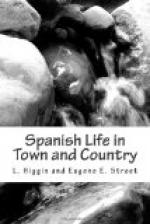The clipping of mules and donkeys, which are also very superior animals to anything we know by that name, is in the hands of the gypsies, who have a perfect genius for decorating their own animals and any others committed to their manipulation. Only the upper part is shaved, or clipped to the skin, the long winter coat being left on the legs and half-way up the body. Generally, on the shoulders and haunches a pattern is made by leaving some of the hair a little longer; the figure of the cross with rays is not uncommon, but it is wonderful how elaborate and beautiful some of these patterns are, looking as if embossed in velvet on the skin. One day, passing a venta in a street in Madrid, we were attracted by a gaily-decked donkey standing outside. He had the words, Viva mi Amo (Long live my Master!), finished with a beautiful and artistic scroll pattern, in rich velvet across his haunches. While we stood admiring this work of art, the master within laughingly warned us that the ass kicked if anyone came near him. Perhaps the elaborate decoration was a practical joke!
The mules and donkeys which come in from the country are generally very picturesque, with a network of crimson silk tassels over their heads, and a bright-coloured manta thrown across their sleek, glossy backs. These mantas serve many purposes; they are made of two breadths of brightly striped and ornamented material of wool and silk, sewn up at one end, or sometimes for some distance at each end, like a purse; sometimes they are thrown across the mule to serve as saddle-bags, sometimes one end is used as a hood and is drawn over the master’s head, while the remainder is thrown across his chest and mouth and over the left shoulder. The best of these mantas are elaborately trimmed at both ends with a deep interlacing fringe, ending in a close row of balls, and have a thick ornamental cord sewn over the joining. These, which are intended for human wraps and not as saddle-bags, are only sewn up at one end, so as to form something very like the old monkish hood. All the horses, mules, donkeys, and oxen wear bells: the oxen have generally only one large bronze bell, which hangs under the head; the others have rows of small jingling silver or brass bells round their collars or bridles.




